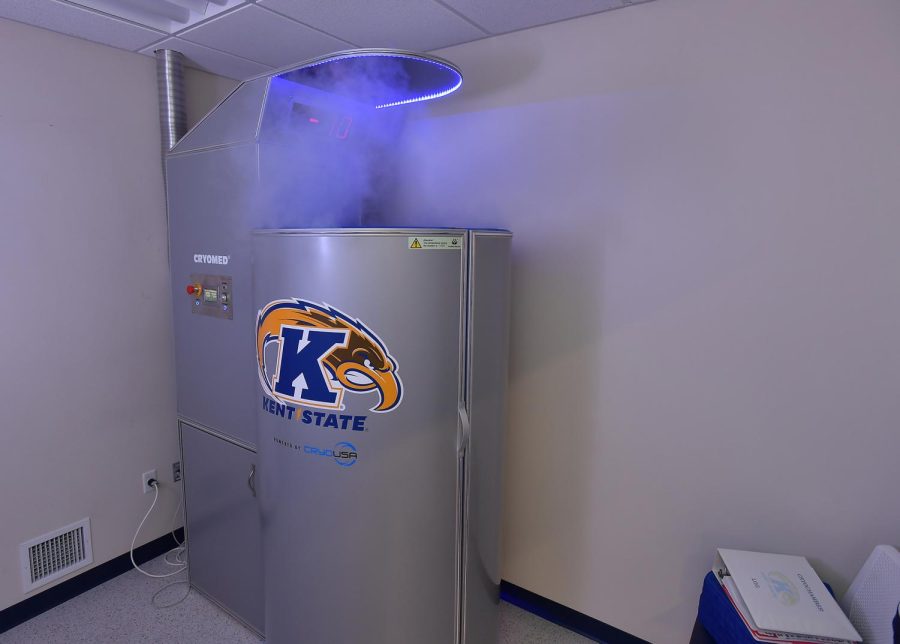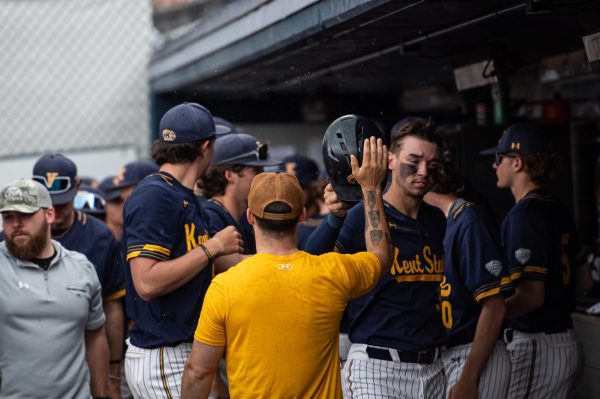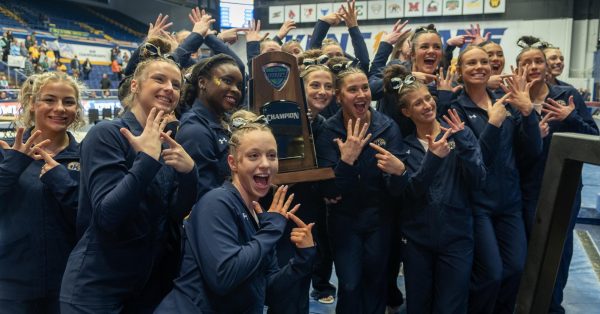‘Like something out of a spaceship’: Kent State athletes use cryotherapy for recovery
The Kent State athletic department’s state-of-the-art cryotherapy chamber. The $50,000 device is being used to help student-athletes recover from minor bumps, bruises and soreness after competitions and practices.
February 4, 2018
Jordan Korinek and the Kent State women’s basketball team needed a quick and simple way to recover after a grueling road trip at the Play4Kay Showcase in Las Vegas, which saw the Flashes play three games in three days some 2,100 miles from home.
When the Flashes returned home bruised and sore from their travels, teammates took turns recuperating in a five-foot barrel of liquid nitrogen chilled to -230 degrees Fahrenheit, a scene that looked like it was ripped straight from a science-fiction space opera.
When the players exited the machine, they felt the same effects they normally would after more traditional methods like ice baths.
The difference?
This method only took three minutes.
The athletes underwent “whole body cryotherapy,” which the Kent State athletic department is using to aid in muscle recovery and pain management.
Physical exertion for student-athletes, whether it be after practice or competition, allows lactic acid to build up in the bloodstream, said Michelle Rura, the assistant athletic director for sports medicine. This lactic acid causes muscle soreness and bumps and bruises for players.
Rura said the sub-zero temperatures of the cryotherapy chamber cause the blood vessels to contract and constrict. This flushes out the blood that has been tainted with lactic acid and allows new, healthier blood to flow through the vessels. In turn, this relieves muscle soreness and “repairs them from whatever damage happened during their participation.”
The main selling point for whole-body cryotherapy is the duration of the treatment. The three-minute process is equivalent to a 15- to 20-minute ice bath, said Trent Stratton, the associate athletic director for sports medicine, sports performance and student-athlete well-being.
“The benefits are a lot quicker,” Korinek said. “It’s only three minutes in there. Overall, it’s just helped our team so much. We used it after the Vegas trip. It helped us recover a lot quicker.”
With those colder temperatures and faster recovery speeds comes a sensation unlike what most people have felt before.
“It feels like you walked out in the freezing cold to get your newspaper in the morning, except you’re in your underwear,” Stratton said.
Stratton emphasized the athletic department uses the machine only for recovery. There has been anecdotal evidence of cryotherapy being used to treat illnesses from depression to fibromyalgia, but there has been little peer-reviewed research to support those claims.
Cryotherapy is not approved by the Food and Drug Administration as a treatment for the previously mentioned ailments, but the device is approved as safe for use. Stratton argued the cryotherapy chamber is no different than an ice bath, which also hasn’t been certified as a healing technique by the FDA.
The cryotherapy chamber at Kent State is the first of its kind to be offered by a Mid-American Conference school, but many other universities and high-profile athletes have jumped on the train, including LeBron James, the University of Alabama and the Philadelphia Eagles.
Stratton played an integral part in the design and acquisition of the athletic department’s new facility, which includes the cryotherapy chamber. He is one of three employees who is certified to operate the machine. He said at the end of each year, the athletic department determines items they need and ones they want.
“We identified that as something that we wanted,” Stratton said. “Then we had to go through all the university channels and get a whole bunch of safety measures and precautions in place and figure out the best way to utilize the space it was going to be in.”
The chamber itself cost $50,000, and each tank of liquid nitrogen costs $100.
While not all teams on campus have chosen to use the cryotherapy chamber as a means of post-activity recovery, Stratton said most of the athletes who have used it have reported positive experiences.
First impressions with the device can be disconcerting, possibly because of the futuristic design of the machine. But as Mitch Peterson, a sophomore guard on the men’s basketball team, said, “You get used to it.”
“It looks like something out of a spaceship,” said Peterson, a frequent user of the chamber. “I was kind of intimidated by it, but it’s cool now that I’ve got used to it.”
Korinek and her teammates on the women’s basketball team are some of the heaviest users of the device. At one point, coach Todd Starkey made the cryotherapy chamber mandatory recovery for players who played over 20 minutes in a game.
“I think we’re still discovering the best ways to use it, but what we’ve been trying to do is be very specific with how we’re trying to use it,” Starkey said. “We’ve had a lot of back-to-back games, so it’s nice to be able to have our players, especially high-minute players, be able to get in it for three minutes and have the benefits of recovery.”
As the department and individual teams and players feel out the most effective and efficient ways to use the cryotherapy chamber, Starkey is looking to the future, seeing the method as a potential tool to entice recruits.
“Recruiting is all about selling the advantage you believe you have over other people, and this is certainly one,” Starkey said. “I think we have some of the best athletic training and healthcare in the league. Parents want to know their kids are being taken care of. It already has been a benefit to us in recruiting.”
Skeptics exist, but Starkey, Peterson and Korinek agree the chamber is a worthwhile investment for the athletic department.
“If you’re going to overdo anything, why wouldn’t you overdo healthcare?” Starkey said. “I could see people being skeptical about the costs we spend on maybe other things — although I don’t think we do anything in an exorbitant way here — but if you’re going to splurge in any area for student-athletes, why not in healthcare?”
Cameron Hoover is the sports editor. Contact him at [email protected].

























